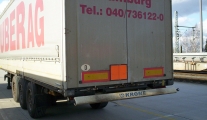Marking of units
Markings in road-rail traffic
Marking of a swap body
Swap bodies used in combined transport (but also in the initial and final leg to the rail
unloading terminal) must have the prescribed placards (25x25 cm) on all four sides.
Marking of a container
Like a swap body the container also has placards on all four sides. The sign for
environmentally hazardous substance also has to appear on all four sides if necessary.
Marking of a tank container
Tank containers in combined transport must have hazard placards on all four sides (5.3.1.2).
The orange plate with the danger code and the UN-number must be affixed on both lateral
sides (5.3.2.1.2 ADR/RID).
If the individual chambers contain different substances each chamber must have an orange plate with danger code and UN-number as well as the necessary placards. The placards at both ends must correspond to the placards on the sides.
Marking of a semitrailer
Since January 1st 2011 the RID allows two possibilities of marking. The one is that orange plates are affixed at the rear AND at the front of the trailer. The other possibility is that the placards are affixed to both lateral sides of the trailer (1.1.4.4.3 RID).

or:
Bulk transportation
If goods are transported in bulk in loading units (swap bodies, containers or semitrailers), the loading unit is marked with an orange plate on both lateral sides in addition to the placards on all four sides. As with the tank container, the danger code and the UN-number must be affixed on the orange plate (5.3.2.1.4 ADR / RID).
Markings in road-rail-ship traffic
Marking of a container for transport by sea
In maritime transport the container also has placards on all four sides. If it contains only one type of dangerous goods and this weighs more than 4 tons, however, the UN-number of this good must be shown on all four sides. This UN-number can be indicated on an orange plate or on a white background in the placard (5.3.2.1 IMDG).
Marking of a tank container for transport by sea
In maritime transport, as in land transport, the tank container has placards on all four sides. The UN-number must also be affixed on all four sides, either in the placard itself or on an orange plate (like the container). If the chambers contain different substances, the UN-number must not be affixed to the end of the tank container.
Marking of a semitrailer for transport by sea
In maritime transport there is a general requirement for “marking”. This includes semitrailers, which means that these also must have placards on all four sides. If the trailer only contains one type of dangerous goods and this weighs more than 4 tons, however, the UN-number of this material must be shown on all four sides. This number can be indicated on an orange plate or on a white background in the placard. The semitrailer shown also has a marking for “Marine Pollutant” substances, the 'fish and tree' sign on all four sides.
Limited quantities in maritime transport
In contrast to overland transport, in which marks for limited quantities have to appear only when containing more than 8 tons, loading units in maritime transport must always be marked on all four sides with the sign for limited quantities, like in this picture.
Marking of waste transports
Marking in Germany
In Germany, loading units in combined transport do not need a special marking when moving by rail. If the waste even is dangerous good, it must be marked in accordance with ADR/RID. On the initial and final leg by road to the terminal, the loading unit or the truck must display a white sign (30 x 40 cm) on which there is a black “A” for “Abfall (waste)” (see § 10 AbfVerbrG, the German regulations governing the transportation of waste) on the front and the rear. The “A” can remain on the loading unit during rail transportation. For international transport, however, the carrier must check whether there are contrary marking rules in the receiving country (e.g. in Italy the “A” is understood to mean “Alimantari”, i.e. food).
Marking in Italy
In Italy, loading units with waste must be marked on all four sides with a yellow plate (25 x 25 cm) on which there is a black “R” (= rifiuti (waste)). This applies explicitly for rail transport as well.
Back to overview


















/teaserpic_quartered)
